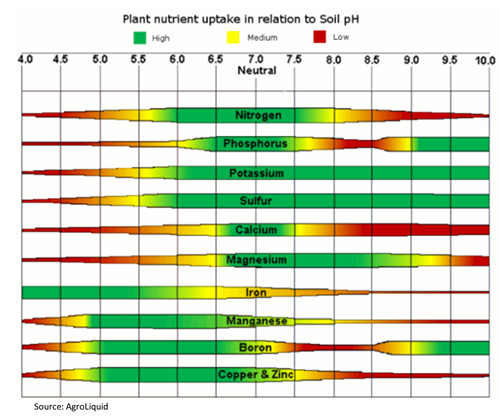Fall Soil Fertility
BY Dairyland Seed Agronomy Team
Harvest is beginning to wrap up, which means it’s time to start planning for the 2023 growing season. A common practice this year was to apply enough fertilizer to cover the crop removal rates instead of building soil fertility levels. An important part of planning for next year is evaluating how well this year’s soil fertility programs worked and deciding what should be applied this fall. With fertilizer prices remaining high, it is a very good idea to take soil samples or review recent soil tests to assess your nutrient levels and form a plan for next year. While looking at your soil test be sure to pay attention to the Soil pH, Cation Exchange Capacity (CEC) and Base Saturation, along with specific nutrient levels.
Soil pH: Soil pH determines nutrient availability to the crop and influences biology in the soil. If the soil pH is off, there could be ample amounts of a nutrient in the soil but still unavailable to the plant. pH measures the acidity or alkalinity of soil. The pH scale is logarithmic, so a pH of 5 has a concentration of H+ that is 10x higher than a pH of 6. The target pH for most crops is about 6.5, with alfalfa being closer to 6.8-7.0. Below is a chart showing nutrient availability at each pH.

Cation Exchange Capacity (CEC): CEC determines the soil’s nutrient holding capacity. Cations are positively charged ions in the soil. Exchangeable cations easily move between soil particles and plant roots (both are negatively charged). Plant roots release C02, which reacts with water to release a H+ cation into the soil. This H+ can bump another cation from a soil particle to be taken up by the plant. Finer textured soil particles such as clays and organic matter have more negatively charged binding sites and therefore higher CEC. Coarse textured soil such as sand has a lower CEC. The main cations that comprise most of the holding capacity are Calcium (Ca), Magnesium (Mg), Potassium (K), Sodium (Na), and Hydrogen (H).
Base Saturation: Base saturation is the amount of the total CEC that is occupied by base cations. The percent Base Saturation is the ratio of these key cations to each other. Too much or too little of these nutrients may cause other nutrients to be unavailable to the crop.
Ideal % Base Saturation for balanced fertility:
- Calcium (Ca)- 65-75%
- Magnesium (Mg)- 13-18%
- Potassium (K)- 3-8%
- Sodium (Na)- Less than 2%
- Hydrogen (H)- 10-15%
Up-to-date soil tests along with yield maps will help identify any deficiencies or problem areas that need to be addressed for next year. Given the high fertilizer prices, if your soil tests show ideal pH, Base Saturation, and adequate nutrient levels, then applying only what the crop needs for next year might be the best management option. If your soil tests show a need for potassium and/or phosphorous then you should consider a fall application to save time in the spring and avoid the higher fertilizer demand. If you have any questions please reach out to your local DSM or Agronomist.
 |
 |
 |
 |
 |
| Brian Weller Western Region 507.456.3034 |
Dan Ritter Central Region 219.863.0583 |
Branden Furseth Northern Region 608.513.4265 |
Mark Gibson Eastern Region 260.330.8968 |
Amanda Goffnett Eastern Region 989.400.3793 |
